Charles Marvin Vorce, 1843-1901
by Brian Stevenson
last updated January, 2023
C.M. Vorce
performed significant roles in the development of many aspects of microscopy.
He was a founding member of the American Society of Microscopists, and one of
its original vice presidents. Vorce was elected to the Royal Microscopical
Society in 1880, and remained a Fellow to the end of his life. He wrote
numerous articles on mounting and illumination techniques, which were published
on both sides of the Atlantic. In addition to recreational and scientific
microscopy, Vorce, who was a lawyer, did much to develop the use of microscopy
for crime scene investigations and the detection of fraudulent handwriting and
foodstuffs.
Vorce’s
microscope slides are generally of very good quality, with
professional-looking, printed labels (Figure 1). However, evidence suggests
that Vorce prepared these for exchange, not sale. Known slides, such as those
illustrated in Figure 1, were produced during the 1870s or early 1880s. It is
likely that Vorce also made permanent slides after that time, although such
slides are not currently known.
The US had
a vibrant microscopy community during the latter half of the 19th
century, with numerous professional and amateur microscopists producing slides
for sale or trade. Many of those slides are of high quality, and well worthy of
inclusion in collections. It is unfortunate that Victorian-era slides by
American makers are rarely seen for sale. We hope that publicizing early US
mounters will encourage current owners to bring their grandparents’ slides down
from the attic and share those treasures.
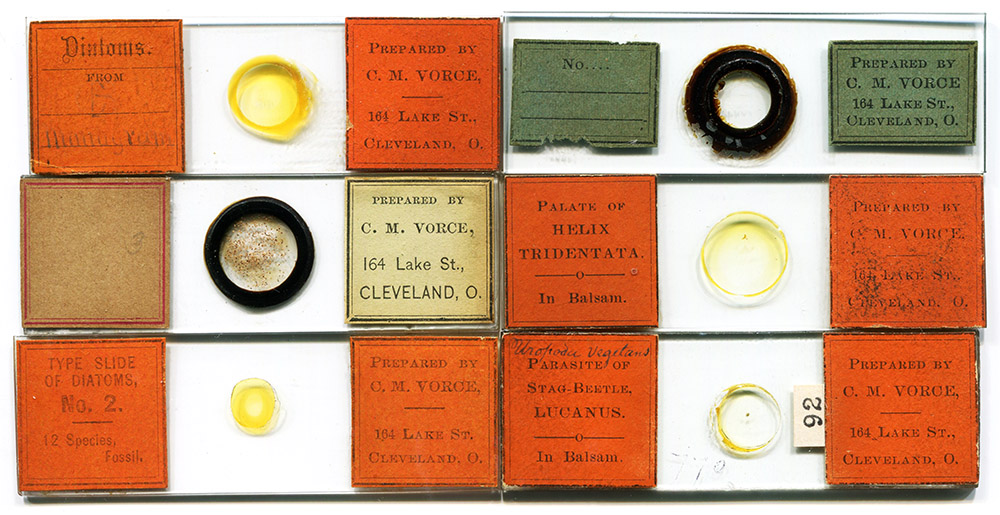
Figure 1.
Microscope slides by C. M. Vorce. Although the labels are professional-looking, Vorce was an amateur who appears to have only exchanged slides among colleagues. From the address, it can be concluded that these slides were produced between the 1870s and early 1880s.
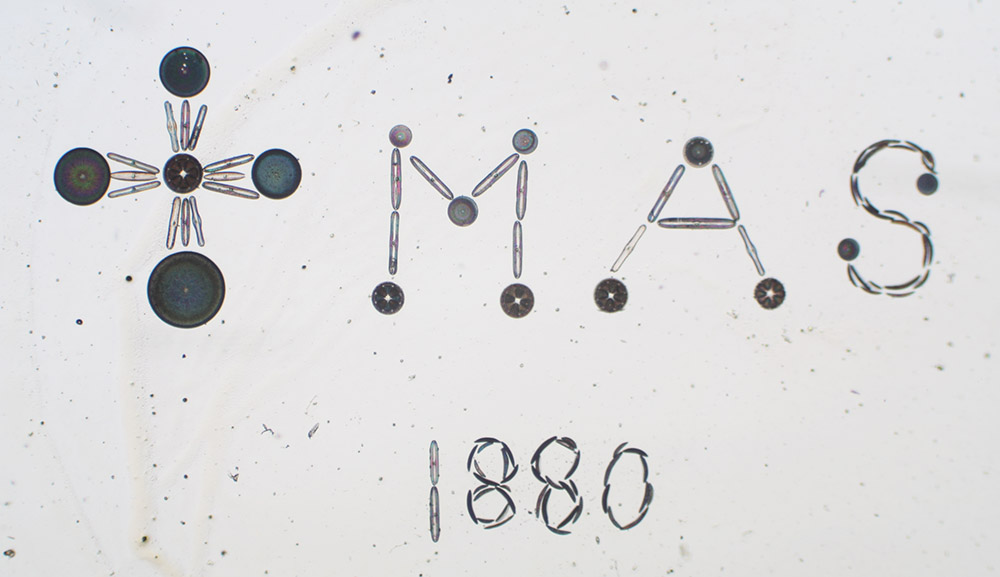
Figure 2.
An arrangement of diatoms, evidently made by Charles Vorce for Christmas 1880. Photographed using a 3.5x objective lens and C-mounted digital SLR camera.
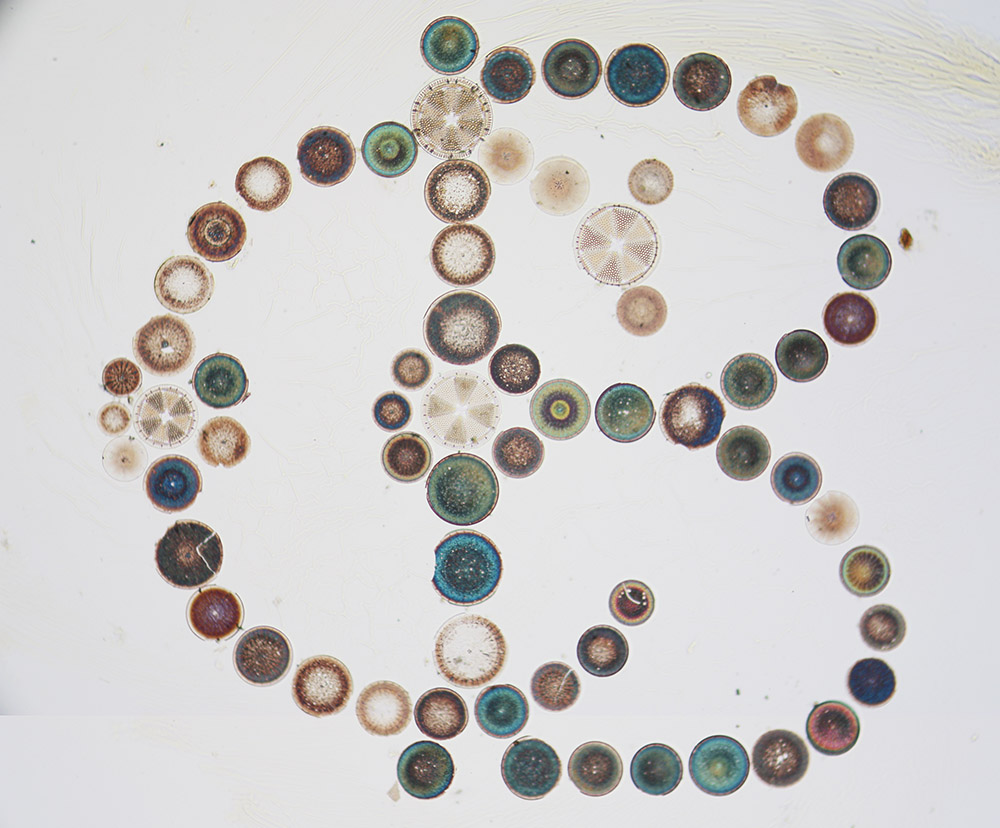
Figure 3.
Diatoms arranged by Charles Vorce to form the monogram "C B". The significance of the letters is not known - perhaps Canada balsam? Photographed using a 3.5x objective lens and C-mounted digital SLR camera.
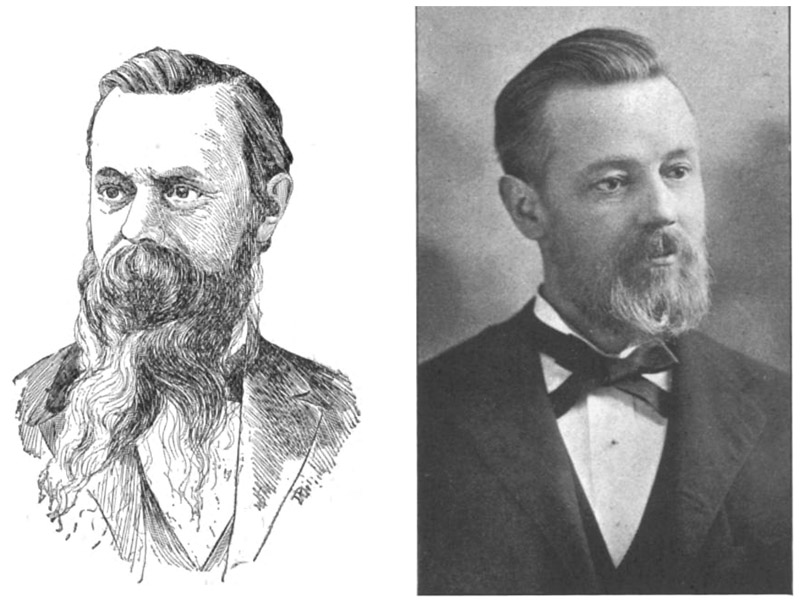
Figure 4.
Charles M. Vorce. The engraving, left, is from a
brief biography published in ‘Practical Microscopy’ during 1895. The photograph,
right, is from his 1901 book on the Vorce family genealogy. It was also used in
the 1903 obituary published in ‘The Transactions of the American Microscopical
Society’.
Charles Marvin Vorce was born in Pulaski, Oswego County, New York, on
November 10, 1843. He was the
first child of Rufus and Susan (nee Marvin) Vorce. His father had previously
married, in 1839, but both his wife and their only child had died by the time
Charles was born. Two of Charles’ three brothers died in infancy, the youngest dying
in 1849 at only 2 weeks of age. Their mother died one week afterward. Rufus
moved his two sons to Cleveland, Ohio in 1852, and there married Phoebe Ann
Denton in nearby Euclid. That September, Charles’ remaining brother died, at
the age of 5. Rufus and Phoebe had 5 children, 3 of whom survived to adulthood.
Charles attended college in Ottawa, Illinois in 1857, then returned to
Ohio in 1860. He served in the Union Army during the Civil War, with the 84th
and 150th Ohio Volunteer Infantry Regiments.
Vorce passed the Ohio bar examination in
1867, and practiced law in Cleveland for the remainder of his life. He was a
partner of Prentiss & Vorce, the oldest law
firm in Cleveland. He had a long-standing interest in mechanics, chemistry and
other sciences, and his legal business inclined in those directions, such that
he became a prominent patent lawyer.
On January 27, 1868, he married Evalyn Marshall, of Oregon, Illinois,
in January, 1868. They had two sons, Loren and Myron, both of whom lived to adulthood.
Vorce developed an interest in microscopy while at school in the late
1850s. After establishing his law business, Charles was able to devote
considerable free time to his microscope.
He helped
organize the American Postal Microscopical Society in 1875. Has served as a
manager of this society from its origin until 1895. His involvement with that
group, which shared boxes of slides made by members, suggests that microscope
slides made by Vorce after 1885 are likely to exist.
The only known advertisements for Vorce’s microscope slides were
published in 1877 and 1878 (Figure 5). Both gave his address of 164 Lake
Street, Cleveland, as is also found on the labels of the slides illustrated in
Figure 1 (above). The Vorces lived in that house through 1884.

Figure 5.
Offers from Charles Vorce to exchange microscope
slides.
In August,
1878, a convention was held in Indianapolis, Indiana, gathering 60 members of
15 American microscopical societies. The convention adopted the permanent
establishment of the American Society of Microscopists. Charles Vorce was
elected a Vice President. He also presented two talks, “Mechanical fingers," describing his invention of “a kind of stage forceps adapted to objects
too small and fragile for ordinary forceps, and as an important accessory for
the microscope, even as a means of study of minute forms and to those who do
not wish to mount objects. Those forms of finger were described which are
attached to the objective or to the movable stage, and the home manufacture of
them recommended as easy and effective. Their efficiency is greater in
proportion to the greater number of movements of the stage and sub-stage. The
apparatus should be furnished with a variety of points for different kinds of
work, varying from a fine mouse-whisker to a split point of whalebone or quill”,
and "A Handy Rule for use in
Micrometry," which “described
very clearly the methods adopted by the author in making microscopical
measurements”.
The
following year’s convention of the American Society of Microscopists was held
in Buffalo, New York. Vorce presented a paper on "The destructive power of certain insects". At the exhibition
soiree, “Mr. C.M. Vorce went beyond many of his co-laborers by showing a monstrosity existing
even among the lowest of animals. It was a specimen of the jaws of a leech, the
owner of said jaws having sported two rows of teeth, one of which intersected
the other, instead of one. He also had the eye of a lobster and a number of
other specimens”.
Talks by
Vorce at subsequent conventions were illustrative of his diverse interests. In
1879, he delivered talks on “Penetration of
objectives; is it a defect or an advantage?” and “The microscopic examination of writings for detection of forgery, etc.”.
The following year, he spoke of “Wholesale
destruction of Acari by a fungus”, and “Forms
observed in water of Lake Erie”, a description of diatoms and other aquatic organisms.
Charles
Vorce was elected as a Fellow of the Royal Microscopical Society in 1880.
Although I have not found any records of Vorce traveling to London for
meetings, he did exhibit slides, such as “crystals
of uric acid from Lepidoptera” at the 1884 Annual Meeting. The RMS
frequently reprinted or commented upon Vorce’s American publications. Those
included, in 1885, articles on taking multiple photographs on a single camera
plate, producing magic lantern transparencies, and making copies of drawings.
In 1881,
Vorce published an extended series of articles in the American Monthly
Microscopical Journal on the use of the microscope for examining foods for
adulteration. Among other things, he revealed that ground coffee sold in
Cleveland contained a substantial amount of starch from peas.
Vorce hosted the 1885 convention of the American Society of
Microscopists, in Cleveland (Figure 6).
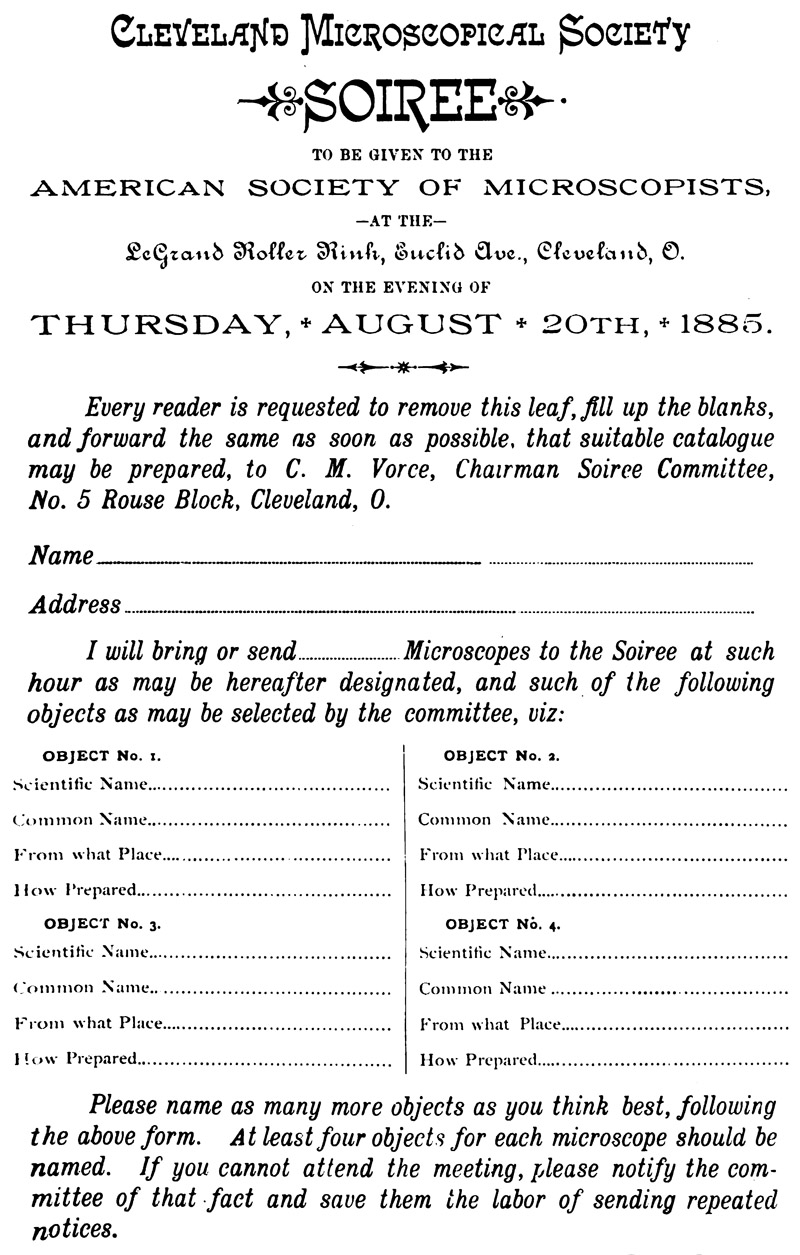
Figure 6.
Registration form for the soiree of the 1885
convention of the American Society of Microscopists, hosted by C.M. Vorce and
the Cleveland Microscopical Society. From the American Monthly Microscopical
Journal.
An experienced slide-maker, Vorce frequently published mounting tips.
Among these, “Expanding
the Blow Fly's Tongue: If the head of a living fly be cut off the tongue will
usually retract; pressure on the head will expand the tongue, but unless it be
secured by some means before the pressure on the head is released it is apt to
wholly or partly retract again. If only the tip is wanted, it is easily secured
by placing the severed head on a clean slip and pressing it with a needle till
the tongue is fully expanded, when a drop of turpentine is applied, a cover
laid on the tongue, and a clip applied before the pressure is removed from the
tongue. To secure the whole tongue, split one end of a small stick for an inch
or so, and holding the split open by a knife-blade, place the severed head in
the cleft with the top downward, and, withdrawing the knife-blade, allow the
stick to close upon the head, when it will fully distend the tongue. Now dip
the head and tongue in turpentine and leave it immersed for a few days, when it
will be found well cleaned, still perfectly distended, and can be released from
the stick or cut from the head without danger of its collapsing. Mounted in a
cell in balsam it is a truly beautiful object”, and “Cells and Cements: Such objects as this
fungus, or indeed any dry-mounted objects, when designed for paraboloid or similar
illumination, should be mounted in a cell of some solid substance. Never use
rings of wax, nor any cement like zinc white, asphalt, or gold size for cells
in dry mounting, and especially shun their use for all but the very shallowest
cells in any mounting. For thin cells use tin-foil or lead-foil; for thicker
use sheet lead, brass, copper, or celluloid; for deep cells use bone, hard
rubber, or brass rings. Cement the cells to the slip with good, hard cement.
When thoroughly dry spin a thin coat of a quick-drying finish on the inside of
the cell to cover its junction with the slip. When the last is completely dry
mount the object, using but little cement between the cover and cell. After
long drying, spin finishing cement on the outside of cell to cover junction of
slide, cell, and cover. When that is thoroughly dry, the mount is complete; and
it will be permanent, free from ‘sweating’, and will never be troubled with
‘running in’ of the cement”.
In 1891, he described his new invention, the “graphological microscope”. Vorce noted that “Among the most important of the applications of the microscope to what are called ‘business uses’ is the
examination of writings, books, etc. The use of the microscope
for such purposes has rapidly increased in the last ten or fifteen
years, until now scarcely a case of importance whose turning point rests on the
authenticity of written or printed matter, is tried without the papers or books in question being submitted to
microscopical examination at the hands of experts, real or supposed. Among the
points to which such examinations are applied may be mentioned the detection of
forgery, alteration, erasure, interpolation, etc., the detection of the
authorship of simulated or anonymous writing, the determination of relative age
of different writings, identity or difference in inks, pencil marks, paper,
etc.; detection of erased writings, the character of stains, marks, mutilations
on paper and elsewhere. Many of the questions involved require very
delicate and prolonged examination for their determination, and sometimes the
use of high powers, but by far the greater number of questions involve the use
of but low or medium powers, and usually the examination of considerable
surfaces. Probably every microscopist who has had occasion to examine writings
to any extent has felt the inconvenience of the best modern microscopes for
that purpose, owing to their limited stage room and short rack. In very many
cases the examination required involves the comparison of a considerable number
of papers, and often of the entire surface of a good sized sheet of paper. The
examination of books, such as hotel registers, Bibles, account books, etc., is
almost impossible of satisfactory accomplishment with ordinary microscopes, the
only way to proceed being usually to place the instrument on the book and focus
through the stage-well .. The danger of marring or obliterating some portions
of the writing to be examined often prohibits the placing of the microscope upon the writing or moving it about, and
renders a satisfactory examination quite impossible”. Vorce’s
graphological microscope remedied those problems by suspending a compound
microscope over a very large stage, which can move horizontally in all
directions (Figure 7). Thus, a paper can be laid upon the stage, and examined
in its entirety without moving either the paper or the microscope body. Vorce’s instrument was custom manufactured for him by Bausch and Lomb.
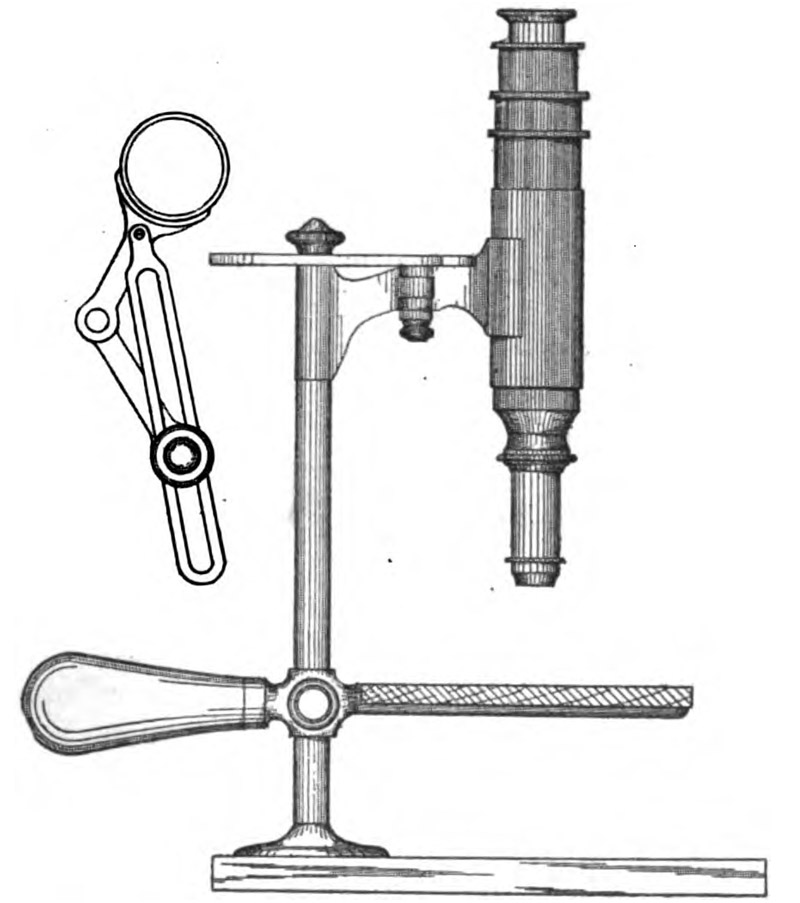
Figure 7.
Charles Vorce’s “Graphological Microscope”, for the
close examination of papers, books, etc.
“On the morning of December 18,
1901, (Charles Vorce) started, well and happy, for his office, but telephoned that he would stop on the way to do some
shopping. He entered one of the
great department stores, made his way slowly through the holiday throng that
crowded the aisles, and was quietly selecting Christmas gifts for his friends, when, without warning, he
fell in a faint to the floor. But the rest that came so suddenly was eternal.
His long overtaxed system had reached its limit”.
Richard Halsted Ward, who wrote the above description of Vorce’s final
hours, described his colleague, “There
was nothing narrow-minded, selfish, or provincial in his principles, his
interests, or his acts. A thorough cosmopolitan and a microscopist of the old
school, like Quekett, and Beale, and Carpenter, and many others that might be
mentioned, he cultivated and cherished microscopy in its broadest sense, both as a science and as an art.
He was always ready to contribute facts or ideas from his own special lines to
those working in other fields, and to take an appreciative interest in their own special undertakings; but he was
pleased most of all to give friendly hints, needed information, and suggestive
criticism to amateurs or beginners
who were trying to enlarge their sphere of vision”.

Figure 8.
Two more of Charles Vorce's slides of arranged diatoms, forming the letters "C" and "B". Both shown at the same magnification. Photographed with a 3.5x objective lens and C-mounted digital SLR camera on a Leitz Ortholux II microscope.
Resources
The American Journal of Microscopy and Popular Science (1877) Exchange offers from
Charles Vorce, Vol. 2, pages 92, 108, 124, 134, and 171
The American Monthly Microscopical Journal (1881) “Mr.
C.M. Vorce has found that the ground coffee sold in Cleveland, the greater part of which is
ground in that city, contains a considerable proportion of starch, which he was inclined to regard for a long time as a mixture of pea and bean starch. But further investigation, without the aid of the
microscope, has shown that only peas are used there, in the sophistication of
the ground coffee, and these are bought by the
car-load”, Vol. 2, page 200
The American Monthly Microscopical Journal (1885) Registration form for the Soiree of the
American Society of Microscopists, Vol. 6, page ix
The American Naturalist (1878)
Exchange offer from Charles Vorce, Vol. 12, pages 261 and 411
The American Naturalist (1878)
National microscopical congress, Vol. 12, pages 702-706 and 764-767
Cleveland Medical and
Surgical Reporter (1902) “Charles M. Vorce, In
the death of this brilliant attorney our College should have more than a
passing interest, for the reason that at one time he lectured on Microscopy. He
was very popular and his lectures were strong presentations of his subject. He
was a practical microscopist, which accomplishment was of great assistance to
him in his work. His death was sudden, being the result of organic heart
trouble”, Vol. 10, page 6
Journal of Applied
Microscopy and Laboratory Methods (1900) Report of the twenty-third
annual meeting of the American Microscopical Society, Vol. 3, page 932
The Journal of Microscopy
and Popular Science (1879) Proceedings of the American Society of
Microscopists, held at Buffalo, N. Y., Aug. 19, 20 and 21,1879, Vol. 4, pages
210-212
Journal of the Royal
Microscopical Society (1884) Report of the Annual Meeting of February 13,
1884, Series 2, Vol. 4, pages 327-329
Journal of the Royal
Microscopical Society (1885) Multiplying Drawings, Series 2, Vol. 5, pages
527-528 (reprinted from The American
Monthly Microscopical Journal, 1884, Vol. 5, pages 207-208)
Military records of Charles M. Vorce, accessed through
ancestry.com
Naturalists’ Universal
Dictionary (1878) Vorce, C.M., 164 Lake St., Cleveland, O, Cassino,
Salem, Mass
Practical Microscopy (1895)
Charles Marvin Vorce, Vol. 6, page 77
Science (1880)
Meeting of the American Society of Microscopists at Detroit, Vol. 1, pages
160-163
Street directories of Cleveland, Ohio, accessed through
ancestry.com
USA censuses, accessed through ancestry.com
Vorce, C.M. (1879) The mechanical finger, The American Journal of Microscopy, Vol. 5, pages 65-66
Vorce, C.M. (1880) On penetration, The American Journal of Microscopy, Vol. 5, pages 183-184
Vorce, C.M. (1881) Wholesale destruction of Acari by a fungus, Proceedings of the American
Society of Microscopists, Vol. 4, pages 49-50
Vorce, C.M. (1881) Forms observed in Lake Erie, Proceedings of the American Society of
Microscopists, Vol. 4, pages 51-60
Vorce, C.M. (1881) Detection of adulteration in food, The American Monthly Microscopical Journal,
Vol. 2, pages 1-4, 122-125, and 161-164
Vorce, C.M. (1881) Is it Tintinnus?, The American Monthly Microscopical Journal, Vol. 2, page 223
Vorce, C.M. (1883) Microscopic forms observed water of Lake Erie, Proceedings of the American Society of Microscopists, Vol. 6, pages 187-196
Vorce, C.M. (1883) The detection of adulteration in food, The American Monthly Microscopical Journal, Vol. 4, pages 24-26
Vorce, C.M. (1884) Expanding the blow fly's tongue, The American Monthly Microscopical Journal, Vol. 5, page 12
Vorce, C.M. (1884) The Measurement of blood-corpuscles, The American Monthly Microscopical Journal, Vol. 5, pages 17-18
Vorce, C.M. (1885) Compound negatives, Journal of the Royal Microscopical Society, Series 2, Vol. 5, pages 331-332 (reprinted from The American Monthly Microscopical Journal, 1885, Vol. 6, pages 13-14)
Vorce, C.M. (1888) The affinities of Raphidodiscus, The Microscope, Vol. 8, pages 132-137
Vorce, C.M. (1891) The graphological microscope, The Microscope, Vol. 11, pages 47-50
Vorce, C.M. (1891) Carbolic acid mounting, The American Monthly Microscopical Journal,
Vol. 12, pages 57-58
Vorce, C.M. (1891) Cells and cements, The American Monthly Microscopical Journal, Vol. 12, page 59
Vorce, Charles M. (1901) A Genealogical and Historical Record of the
Vorce Family in America,
Vorce, Cleveland
Ward, R.H. (1903) Charles Marvin
Vorce of Cleveland Ohio, Transactions of
the American Microscopical Society, Vol. 24, pages 163-170







